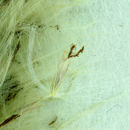Comprehensive Description
provided by North American Flora
Imperata hookeri Rupr.; Anderss. Oefv. Sv. Vet.-Akad
Forh. 1855 : 160. 1855.
Imperata caudata Scribn. Bull. Torrey Club 9 : 86. 1882. Not /. caudata Trin. 1833. Imperata brevifolia Vasey, Bull. Torrey Club 13: 26. 1886.
Stems 5-12 dm. tall ; leaf-sheaths smooth and glabrous ; blades up to 5 dm. long and 1 cm. wide, long-acuminate, narrowed toward the base, hirsute on the upper surface near the base; panicle narrow, dense, 1.5-3 dm. long and 2.5 cm. wide, its branches erect, crowded; spikelets 3-4 mm. long, about one third as long as the involucral hairs.
Type locality : Texas.
Distribution : Western Texas to California and Mexico.
- bibliographic citation
- Percy Wilson, Per Axel Rydberg, Norman Taylor, Nathaniel Lord Britton, John Kunkel Small, George Valentine Nash. 1909. PANDANALES-POALES; TYPHACEAE, SPARGANACEAE, ELODEACEAE, HYDROCHARITACEAE, ZANNICHELLIACEAE, ZOSTERACEAE, CYMODOCEACEAE, NAIADACEAE, LILAEACEAE, SCHEUCHZERIACEAE, ALISMACEAE, BUTOMACEAE, POACEAE (pars). North American flora. vol 17(1). New York Botanical Garden, New York, NY
Physical Description
provided by USDA PLANTS text
Perennials, Terrestrial, not aquatic, Rhizomes present, Rhizome elongate, creeping, stems distant, Stems nodes swollen or brittle, Stems erect or ascending, Stems caespitose, tufted, or clustered, Stems terete, round in cross section, or polygonal, Stem nodes bearded or hairy, Stem internodes solid or spongy, Stems with inflorescence less than 1 m tall, Stems with inflorescence 1-2 m tall, Stems, culms, or scapes exceeding basal leaves, Leaves mostly basal, below middle of stem, Leaves conspicuously 2-ranked, distichous, Leaves sheathing at base, Leaf sheath mostly open, or loose, Leaf sheath smooth, glabrous, Leaf sheath hairy at summit, throat, or collar, Leaf sheath and blade different iated, Leaf blades linear, Leaf blades 2-10 mm wide, Leaf blades 1-2 cm wide, Leaf blades mostly flat, Leaf blade margins folded, involute, or conduplicate, Leaf blades mostly glabrous, Leaf blades scabrous, roughened, or wrinkled, Ligule present, Ligule a fringed, ciliate, or lobed membrane, Inflorescence terminal, Inflorescence an open panicle, openly paniculate, branches spreading, Inflorescence a dense slender spike-like panicle or raceme, branches contracted, Inflorescence solitary, with 1 spike, fascicle, glomerule, head, or cluster per stem or culm, Inflorescence lax, widely spreading, branches drooping, pendulous, Inflorescence a panicle with narrowly racemose or spicate branches, Inflorescence single raceme, fascicle or spike, Inflorescence with 2-10 branches, Peduncle or rachis scabrous or pubescent, often with long hairs, Flowers bisexual, Spikelets pedicellate, Spikelets sessile or subsessile, Spikelets dorsally compressed or terete, Spikelet less than 3 mm wid e, Spikelets with 1 fertile floret, Spikelets with 2 florets, Spikelet with 1 fertile floret and 1-2 sterile florets, Spikelets paired at rachis nodes, Spikelets in paired units, 1 sessile, 1 pedicellate, Spikelets bisexual, Spikelets disarticulating below the glumes, Spikelets conspicuously hairy , Rachilla or pedicel glabrous, Glumes present, empty bracts, Glumes 2 clearly present, Glumes equal or subequal, Glumes equal to or longer than adjacent lemma, Glume equal to or longer than spikelet, Glume surface hairy, villous or pilose, Glumes 3 nerved, Glumes 4-7 nerved, Glumes 8-15 nerved, Lemmas thin, chartaceous, hyaline, cartilaginous, or membranous, Lemma 1 nerved, Lemma glabrous, Lemma apex acute or acuminate, Lemma awnless, Lemma margins thin, lying flat, Lemma straight, Callus or base of lemma evidently hairy, Callus hairs longer than lemma, Palea present, well developed, Palea membranous, hyaline, Palea longer than lemma, Stamens 1, Styles 1, Stigmas 2, Fruit - caryop sis.

